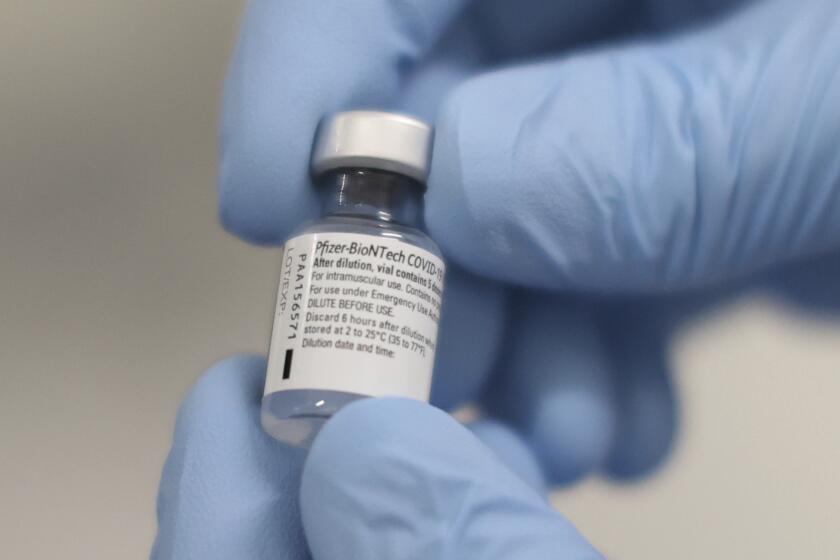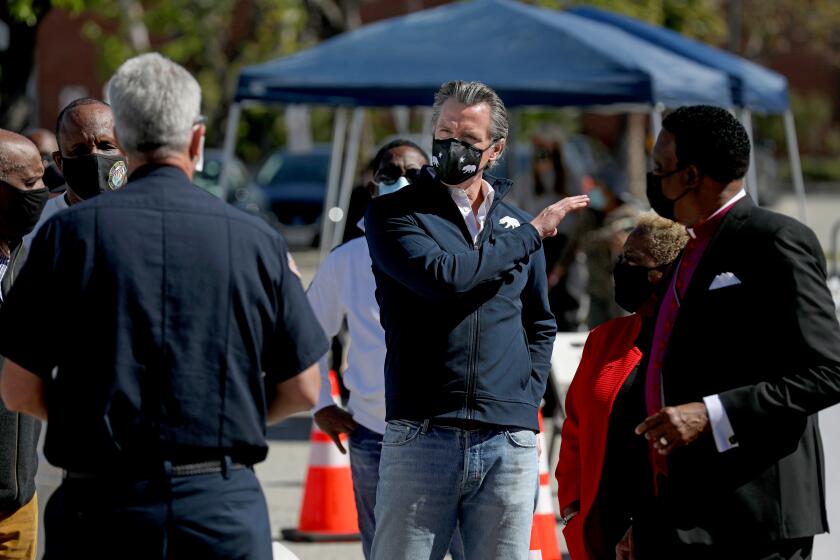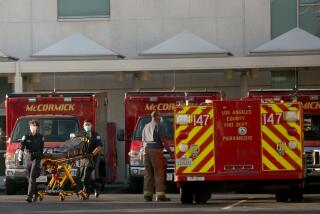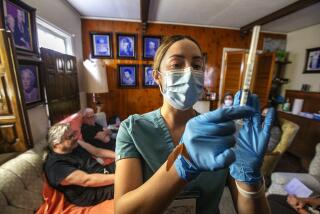Why wealthy spots like Beverly Hills, San Marino have the highest COVID vaccination rates
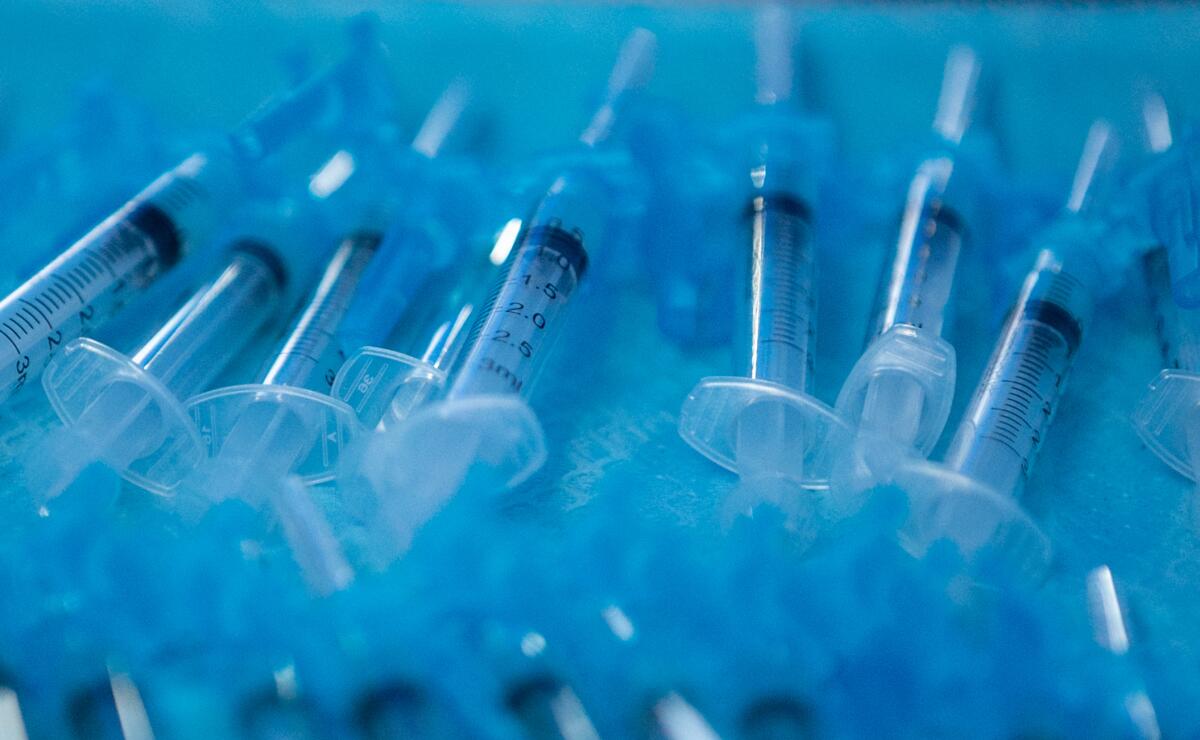
Striking inequities are emerging in the COVID-19 vaccine rollout, with residents of wealthy areas receiving far more vaccinations than those in poorer neighborhoods, data show.
Los Angeles County’s wealthiest and more predominantly white cities have a far greater percentage of residents vaccinated for COVID-19 than its poorest regions, home to large Black and Latino populations.
“The findings clearly indicate very significant inequities in the distribution of vaccine to date,” said Dr. Paul Simon, chief science officer for the Los Angeles County Department of Public Health. “These inequities are unjust and unacceptable and demand renewed efforts to address them.”
A Times analysis found that areas hardest hit by the pandemic have the lowest vaccination rates. In South L.A., only 1 out of 24 people are vaccinated — a low rate for L.A. County — while 1 in 6 coronavirus tests come back positive.
Simon said one of the biggest barriers to vaccinations has been the appointment registration process.
“The websites have been flooded with folks trying to get an appointment. And so those people who have the luxury of time can spend, literally in some cases, hours, I’m sad to say, working to try to get an appointment,” Simon said. Many seniors have relied on their children, nieces, nephews or other friends who are more comfortable using the internet to help get them an appointment.
In addition, the use of so-called mega-POD (point of distribution) sites in the county — such as the Forum and Pomona Fairplex super sites — has been criticized. They’re off-putting for those trying to avoid large crowds, critics say, and the demographic served often doesn’t reflect the county’s poorer residents.
Simon said the strategy of using massive sites was done to dispense vaccinations quickly and has been successful in that regard. “We’re using more than 90% of our supply within four days of receiving it,” he said. “But those big mega-PODs don’t necessarily work so well for these underserved communities.”
Distributing the vaccine is considered the center of efforts to finally bring COVID-19 under control. But demand has far outstripped the limited supply.
Los Angeles County recorded its 20,000th death from COVID-19 on Tuesday, a tragic milestone that came as California’s cumulative death toll neared 50,000 and as the national death toll passed 500,000 Monday.
But those tallies come amid a dramatically improving picture. Daily coronavirus case counts in Los Angeles County are reaching lows not seen since early November, during the first few weeks of the autumn-and-winter surge. L.A. County recorded an average of 2,000 cases a day for the seven-day period that ended Tuesday, down 87% from early January, when there were more than 15,000 new cases a day.
L.A. County recorded about 120 deaths a day on average over the past week, half as much as during the peak in early January, when 241 deaths a day were recorded.
Black and Latino communities have been hit disproportionately hard by COVID-19, and experts say it’s essential the vaccine get distributed there as quickly as possible.
According to the most recently available data, Latino residents of L.A. County are dying from COVID-19 at triple the rate of white and Asian American residents. For the 14-day period that ended Jan. 30, the average daily COVID-19 death rate for Latinos in L.A. County was 33 per 100,000 residents; for Black residents, it was 14 deaths per 100,000; and for white and Asian American residents, it was 11 deaths per 100,000.
COVID-19 vaccines are now being administered to healthcare workers in the U.S. What are your questions about the timeline, the safety or the science?
Rich vs. poor communities
According to the data released by the L.A. County Department of Public Health, cities and neighborhoods where 25% or more of the populations had received at least one dose of vaccine included Cheviot Hills, Century City, Bel-Air, Beverly Crest, Beverly Hills, Rolling Hills Estates, Encino, Pacific Palisades, San Marino, Palos Verdes Estates, La Cañada Flintridge, Brentwood, Sierra Madre and Rancho Palos Verdes.
But areas with 9% or less of the population vaccinated included broad swaths of South L.A. and southeast Los Angeles County, including the cities of South Gate, Paramount, Lawndale, Lynwood, Maywood, Hawaiian Gardens, Huntington Park, Bell Gardens, Bell, Compton and Cudahy; the Antelope Valley; and other L.A. neighborhoods, including Koreatown, Hollywood and North Hollywood, Little Armenia, Wilmington, Westlake and Thai Town. Avalon, on Santa Catalina Island, also reported a vaccination rate of less than 9%.
Neighborhoods and cities with less than a 10% vaccination rate included Harbor Gateway, Pacoima, Hawthorne, Little Bangladesh, Pico-Union, Inglewood, South El Monte, Boyle Heights, East L.A., Temple-Beaudry and Van Nuys.
Overall, neighborhoods around L.A. County with the lowest vaccination rates were South L.A., East L.A., several regions of the San Gabriel Valley, the eastern San Fernando Valley, the Antelope Valley and several areas near the ports of Los Angeles and Long Beach.
Other imbalances
There is also a gender imbalance among those who have been vaccinated: 59% are female, while 41% are male.
And Black and Latino residents are being vaccinated at a substantially lower rate compared to their proportion of the population: Among vaccines given to L.A. County residents 16 and older, 33.5% have been given to white residents; 23% to Latinos; 19% to Asian Americans; and 5.2% to Black residents. Of L.A. County’s population of residents 16 and older, 46% are Latino and 9% are Black.
L.A. County officials also calculated by race and ethnic group the percentage of seniors who had received at least one dose of vaccine: 42.5% of people 65 and older.
But among racial and ethnic groups, there was wide variation. White seniors were most likely to have received at least one dose, with 42.8% of all white seniors receiving the vaccine; 39.4% of Asian American seniors also had received at least one shot. But only 24% of Black seniors, 29.3% of Latino seniors and 31.7% of Native American seniors had received at least one dose.

Trying to fix the problems
Strategies that officials have proposed to get more vaccine to members of underserved communities include reserving appointment slots for residents of those areas; expanding mobile vaccination units to serve seniors and others with limited mobility; dispatching community health workers to help residents schedule appointments; and expanding transportation services for those in need.
Authorities also are sending more vaccines to healthcare providers in underserved communities, such as clinics and pharmacies.
Officials are allocating an additional 6,000 to 7,000 vaccine doses for residents of South L.A. and 1,000 to 2,000 in the Antelope Valley, Simon said. New vaccination sites will be prioritized in areas with the lowest vaccination rates.
Even as the rate of new coronavirus cases falls, there are still troubling signs of the impact of COVID-19 on Black and Latino communities.
L.A. City Councilman Marqueece Harris-Dawson, who represents South L.A., has been critical of how vaccinations have been distributed. At a City Council meeting in January, he expressed concern about the initial government strategy of routing vaccines to large sites such as the Forum in Inglewood. He said his constituents were “not going to anyplace with big crowds of people” and criticized the demographic makeup of those receiving shots at the venue as not representative of the neighboring community, an observation confirmed by others, including Simon.
Harris-Dawson and others have encouraged the use of mobile vaccine clinics and the practice of routing vaccines to clinics that have a trusted reputation in the community.
Although officials also plan to step up efforts to combat misinformation about the safety of the vaccines, which data have shown to be very safe, Simon said he believed the larger problem right now was lack of access to the vaccine. There are many more Black seniors who desperately want to get the vaccine but have so far been unsuccessful at getting appointments, Simon said.
Times staff writers Sandhya Kambhampati, Iris Lee, Rahul Mukherjee and Ryan Murphy contributed to this report.
More to Read
Start your day right
Sign up for Essential California for news, features and recommendations from the L.A. Times and beyond in your inbox six days a week.
You may occasionally receive promotional content from the Los Angeles Times.
